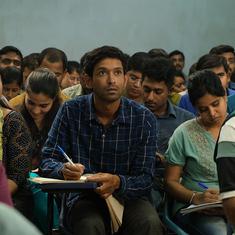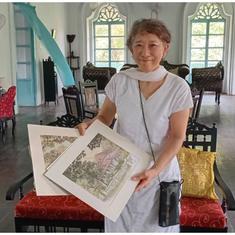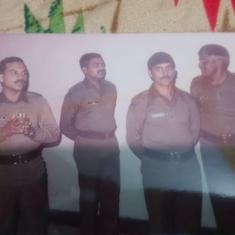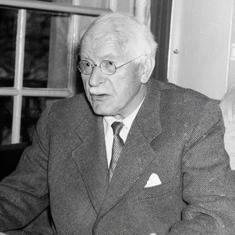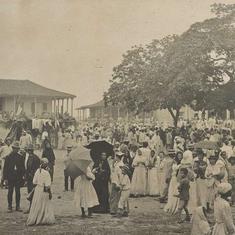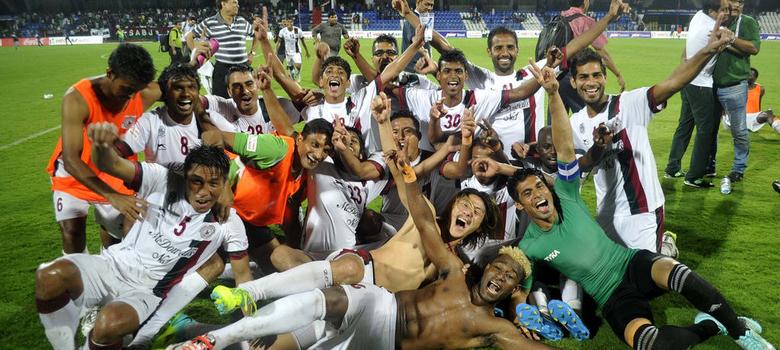There’s a surreal charm in revisiting your roots, and Indian football seemed to have done just that on Sunday evening. Not since 2004 had the perch belonged to the City of Joy, the army of Goan clubs having left Kolkata in its shadows for over a decade. Not since 2010 had the Mariners won a major trophy, gross mismanagement of the club nearly relegating them last season.
So when Belo Rassaq popped up with an equalising header for Bagan five minutes from time, it proved to be a cathartic moment for the club’s supporters. Rassaq, who was later adjudged the league’s best defender, continued the Kolkata club’s long-running reliance on its Nigerian heroes.
Nailbiting finale
The final match of the league lived up to its billing; so much so, in fact, that the #BFCvMMB hashtag topped the nationwide trends on Twitter. It was indeed a thrill-a-minute ride, with a sense of desperation and commitment evident on the field.
The visitors dominated without, somehow, finding the back of the net. Sony Norde, season’s finest forward recruit, ran Bengaluru’s defence ragged from the left wing – hitting the crossbar, testing the goalkeeper time and again, but failing to find the net. He even set up a great chance for Balwant Singh but the Indian managed to miss a sitter.
Cameroonian Pierre Boya, not known for his prolific scoring, sliced over from close range. Katsumi Yusa was lively but fell short of making a decisive contribution like he had done all season long. It was all one-way traffic though, till Bengaluru defender John Johnson headed the home side in front against the run of play just before half-time.
Bagan’s response to going behind was exceptional, and the stuff champions are made of. Coach Sanjoy Sen’s side stepped up a couple of gears, and threw the kitchen sink at their opponents. Only the intervention of a higher power appeared to keep Bagan at bay. That is before the pressure finally told, and Rassaq nodded in Norde’s corner to make it 1-1.
And that was it: The old master, who had threatened to slay the apprentice all season long, had finally succeeded. It was a fitting finale to a thrilling 2015 season of the Hero I-league, a competition whose credibility and longevity seems to be under more threat than ever before.
Whither I-League?
The I-League is recognised by FIFA as India’s main football league, yet there is a growing feeling that it will play second fiddle to the Indian Super League in the near future. Even an unpredictable, exciting and competitive season has done little to suggest otherwise.
Attendances didn’t improve: spectator interest in the sport did not last beyond the glamorous ISL, unlike initially expected. Player fatigue was an evident factor. The season had been pushed to the summer months to accommodate the ISL, and the Federation Cup which preceded the I-league appeared to be an inconvenience being played in front of empty stands.
Hero Motocorp did come on board as title sponsor this season, but the television and digital media coverage continued to be shoddy, especially since the ISL has now set a benchmark for domestic football coverage. The I-League remains a competition in dire need of investment to sustain itself, but it makes little sense for a corporation to invest in it, considering a new cash-rich league is already in town.
Where the teams stand
Goan football, a major pipeline to the Indian national team, is in doldrums. Once regarded highly for their professionalism and sound management, the Goan clubs have fallen away. Churchill Brothers were one of four clubs debarred from the league prior to this season for not fulfilling the licensing criteria. Other Goan clubs fought relegation battles throughout the season.
Dempo, which won five of the last eight national league titles, ended up being relegated, sending shockwaves across the country’s football sphere. The club sacked coach Arthur Papas after a string of poor results and replaced him with Trevor Morgan, with no success. Choosing to be part of the ISL and then loaning out all their players to the local franchise FC Goa was a step too far. The club eventually paid the price for its changed priorities.
There are strong fears they’ll follow the likes of JCT and Mahindra United in disbanding. Playing in the top division is hardly financially rewarding in the first place. To play in the second division with the sole aim of playing in the first might not be feasible at all.
However, Shillong’s football continues to flourish and be a beacon of hope. Coach Santosh Kashyap’s Royal Wahingdoh – the third side from Shillong to play in the I-league – were the season’s big entertainers, playing an attractive brand of football and finishing third. Shillong Lajong too survived a five-team relegation dogfight on the final day in quite some style, thrashing the once-mighty East Bengal 5-1.
East Bengal, on the other hand, sacked coach Armando Colaco mid-season and replaced him with Eelco Schattorie but it made little difference, as foreign signings such as Milan Susak and Leo Bertos failed to make an impact. The Kolkata club capitulated in Shillong in the final round in one of its worst ever top-division performances.
The famous and now refurbished Cooperage Ground returned to the I-league after five years, hosting Mumbai FC amid little excitement and small crowds – a reality check compared to the city’s loud support for ISL franchise Mumbai City FC.
Role model Bengaluru
There’s little doubt that Bengaluru FC, with its unique football culture and British-style set up, remains an institution other clubs must aspire to follow. In only its second year of existence, the Ashley Westwood-masterminded outfit has already lifted the I-league and the Federation Cup once each.
While Bengaluru’s continued success is a measure of what a club can smartly achieve on its own (without the need to rely on the AIFF for assistance) it also exposes the laid-back attitudes and unprofessionalism rampant within Indian football clubs.
Sunday’s title-deciding contest was quite symbolic: It pitted a club with two years of history against one with 126 years of tradition. Yet, the last two seasons have shown that history counts for nothing in India.
Mohun Bagan might be celebrating a league trophy, but the uncertainty as to where the league itself is heading is unsettling. Before the final match, Boya declared he and his teammates are playing for “the biggest trophy in India”.
Lucky for them then that they have it in their cabinet, because the glory of this trophy could soon be a thing of the past.
***
Corrections and clarifications: This article was edited to correctly reflect that Bengaluru FC is in its second year of operation. The club was formed in July 2013. An earlier version of this article erroneously stated that the club is in its third year of operation.

